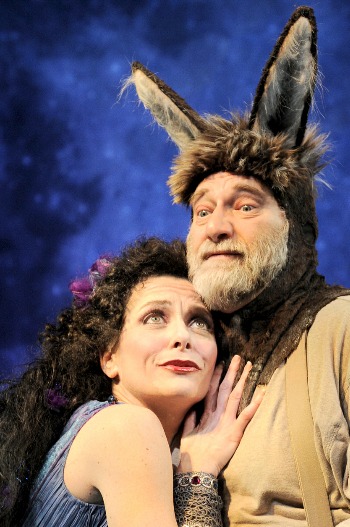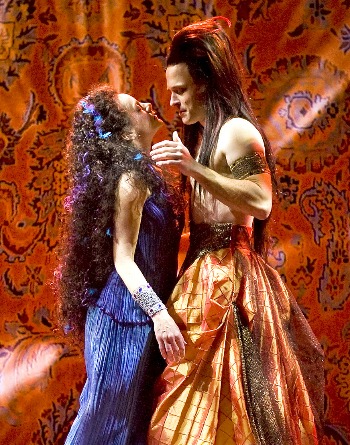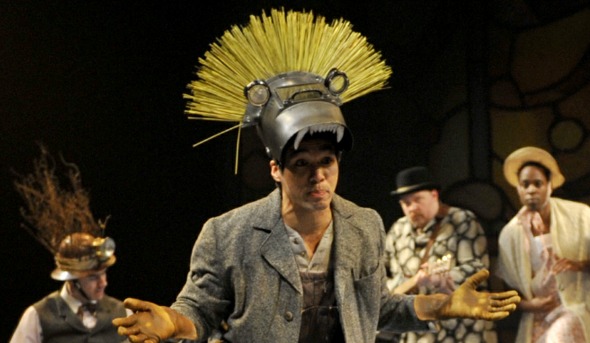Darn that ‘Dream’ – Chicago Shakespeare does double take on Bard’s lovers, fairies
 Review: “A Midsummer Night’s Dream” by William Shakespeare, at Chicago Shakespeare Theater through April 8. ****
Review: “A Midsummer Night’s Dream” by William Shakespeare, at Chicago Shakespeare Theater through April 8. ****
Lawrence B. Johnson
When Shakespeare called his play “A Midsummer Night’s Dream,” he practically beamed a creative challenge to directors in a future that would produce the most astute analyst of human behavior since the Bard himself: Sigmund Freud.
 So in director Gary Griffin’s bold, psychologically layered and enchanting take on “A Midsummer Night’s Dream” for Chicago Shakespeare Theater, set in 1920, who should be the first character we lay eyes on but that cigar-puffing dream surgeon, Dr. Freud. Not to worry, though, Griffin hasn’t inserted the psychoanalyst into Shakespeare’s play. Freud’s appearance is, let’s say, prefatory – and quite amusing.
So in director Gary Griffin’s bold, psychologically layered and enchanting take on “A Midsummer Night’s Dream” for Chicago Shakespeare Theater, set in 1920, who should be the first character we lay eyes on but that cigar-puffing dream surgeon, Dr. Freud. Not to worry, though, Griffin hasn’t inserted the psychoanalyst into Shakespeare’s play. Freud’s appearance is, let’s say, prefatory – and quite amusing.
But make no mistake, Griffin’s interpretation of “Dream” is pointedly Freudian. A case could be made, in the show’s rigorous pursuit of dualities, that it’s actually Jungian. Either way, it’s headlong, hilarious fun that abounds in creative wit. While the actors’ comfort level with Shakespeare’s language is variable, the sum of the enterprise is a midwinter’s charm.
If it’s no great novelty to see the same pair of actors cast both as the Athenian Duke Theseus and his betrothed Hippolyta and as the fairy king Oberon and his queen Titania, it’s a laugh-out-loud shock to find the rough-cut tradesmen – the so-called “mechanicals” who are preparing a play to give at the duke’s wedding – doubling as Titania’s spritely attendants. The more delightful that when those fine fellows morph from tailor, bellows-mender and tinker into Moth, Cobweb and Mustardseed, they exchange their simple weeds for fantastical pajamas and headgear.
More radical than any of this, however, is Griffin’s decision to reverse Shakespeare’s first and second scenes. Rather than beginning with Hermia’s plea to Theseus that she be allowed to marry against her father’s wishes, this “Dream” starts with the mechanicals meeting to plan their play and arrange a rehearsal. In a program note, Griffin contends that switching those scenes affords friendlier, more human access to Shakespeare’s world. He may be right, but the inversion struck me as arbitrary and bizarre, not damaging perhaps but not especially helpful, either.
That issue aside, Griffin’s “Dream” is as seamless, beguiling and swift as it is lusty, imaginative and funny. And at is best, superbly cast. Tracy Michelle Arnold (Hippolyta and Titania) makes Shakespearean magic of the fairy queen, tossing off that gossamer poetry with regal poise and the fluency of natural speech. And in Ron Orbach’s Bottom, the weaver transformed into a long-eared ass and magically consigned to Titania’s adoration, this stately queen has an ideal comedic partner.
 As a good Bottom is wont to do, Orbach’s ruddy, loquacious rustic makes this show his own every time he rouses his great heft to speech. His heart-felt limning as the tragically comical Pyramus in the mechanicals’ wedding play is a campy riot. Nor can we overlook the sweet object of his desire, fair Thisbe, played to a dainty T by Levenix Riddle. (Loved the red purse.) Oh, and the mechanicals’ comical tragedy isn’t merely spoken, but sung in the close harmony of a barbershop quartet.
As a good Bottom is wont to do, Orbach’s ruddy, loquacious rustic makes this show his own every time he rouses his great heft to speech. His heart-felt limning as the tragically comical Pyramus in the mechanicals’ wedding play is a campy riot. Nor can we overlook the sweet object of his desire, fair Thisbe, played to a dainty T by Levenix Riddle. (Loved the red purse.) Oh, and the mechanicals’ comical tragedy isn’t merely spoken, but sung in the close harmony of a barbershop quartet.
Titania’s actual mate, Oberon, in the godly bare-chested form of Timothy Edward Kane, offers the unbuttoned alter-ego of Kane’s uptight Theseus. It’s Clark Kent stepping into a phone booth to become Superman. This matchup of Oberon and Titania is a dream team.
But it’s also to director Griffin’s credit that, in the end, the improbable coupling of Theseus and his conquest-bride Hippolyta also looks like it might last. No small trick, considering that the duke and his lady stand near the top of the list as Shakespeare’s most thankless characters. Anyway, they’re smashing in their matching white outfits.
Speaking of tricks, and tricksters, in the performance I saw the role of Oberon’s mischievous – and often bungling — henchman Puck was played by understudy Maggie Kettering. Griffin has cast Puck as, well, not exactly female but portrayed by a woman. Sprites obviously can be of either gender, or both, which appears to be the present case. I leave that to the reader’s discernment. But Kettering was a game Puck, energetic, saucy and smart.
 Where this production runs into trouble is with those four crazy kids, the scrambled lovers Hermia and Lysander and Helena and Demetrius. While all four gallop full tilt into the fray, in the performance I saw only Matt Schwader, as Demetrius, seemed fully in command of the rhythm and expressive infection of Shakespeare’s language. Each of the others – Andy Truschinski as Lysander, Christina Nieves as Hermia, Laura Huizenga as Helena – tended to rush, mutter or lose the poetic pulse.
Where this production runs into trouble is with those four crazy kids, the scrambled lovers Hermia and Lysander and Helena and Demetrius. While all four gallop full tilt into the fray, in the performance I saw only Matt Schwader, as Demetrius, seemed fully in command of the rhythm and expressive infection of Shakespeare’s language. Each of the others – Andy Truschinski as Lysander, Christina Nieves as Hermia, Laura Huizenga as Helena – tended to rush, mutter or lose the poetic pulse.
Nieves and Huizenga were at their funniest and sharpest in the brawl that ensues when Puck’s errant intervention leads Hermia and Helena to think they’re being played for fools.
CST’s “Dream” unfolds on designer Daniel Ostling’s nearly bare stage, with only a few bright pillows and banners — and Mara Blumenfeld’s opulent costumes – to provide color. Philip S. Rosenberg’s dramatic lighting bears the play upon its back. ’Tis enough to give this night’s reveries the weight and weightlessness (one last duality) of truth.
Related Links:
- Performance location, dates and times: Go to TheatreinChicago.com
- “A Midsummer Night’s Dream” synopsis: Read it here.
- Director Max Reinhardt’s classic 1935 film of “A Midsummer Night’s Dream”: Read about it here.
- Director Michael Hoffman’s 1999 film, set in 1900, with Kevin Kline as Bottom: Read about it here
- Oberon and Titania (Victor Jory and Anita Louise) spar in the 1935 movie: See it at YouTube
- A young Mickey Rooney as Puck in the 1935 movie: See a clip at YouTube
- Judi Dench as Titania, enamored of an ass, in the 1968 film: See a clip at YouTube
- A young Helen Mirren as stubborn Hermia in 1968: See a clip at YouTube
- The Beatles perform the play of the mechanicals: See a clip at YouTube
- Michelle Pfeiffer as Titania in the 1999 film version: See a clip at YouTube
Photo captions and credits: Home page and top: Timothy Edward Kane plays the fairy king Oberon with Tracy Michelle Arnold as his queen Titania. Upper right: Titania (Tracy Michelle Arnold) with Bottom (Ron Orbach) as her transformed lover. Lower right: Titania (Tracy Michelle Arnold) and Oberon (Timothy Edward Kane). Lower left: The scrambled lovers, from left, Demetrius (Matt Schwader), Helena (Laura Huizenga), Lysander (Andy Truschinski) and Hermia (Christina Nieves). Bottom: Richard Manera, as Snug the joiner, portrays Lion with the other mechanicals in their wedding play for the duke. (Photos by Liz Lauren)
Tags: "A Midsummer Night's Dream", Chicago Shakespeare Theatre, Gary Griffin, Mara Blumenfeld, Philip S. Rosenberg, Ron Orbach, Timothy Edward Kane, Tracy Michelle Arnold, William Shakespeare


